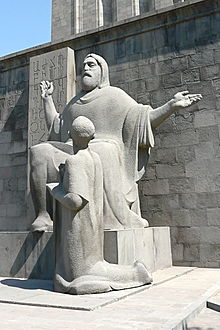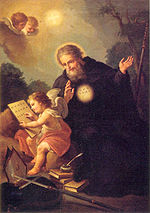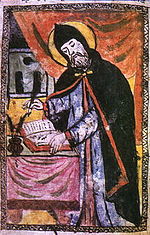- Saint Mesrob
-
St. Mesrop Mashtots 
Statue of Saint Mesrop Mashtots, founder of the Armenian alphabet, at the Matenadaran Institute of Ancient Manuscripts in Yerevan, Armenia. The original letters (i.e. only uppercase) in their original shapes can be seen on the stone plaque.Born 361 or 362 AD
Hatsik, Province of Taron, historical ArmeniaDied February 17, 440
Vagharshapat, ArmeniaHonored in Armenian Apostolic Church, Armenian Catholic Church, Roman Catholic Church Major shrine St. Mesrop Mashtots Church in Oshakan, Armenia Feast The Armenian Church remembers St. Mesrop (together with St. Sahak), twice each year, first in July and then again on the Feast of the Holy Translators in October.[1] Patronage Armenia Saint Mesrop Mashtots (also Mesrob, Mashtotz, Armenian: Մեսրոպ Մաշտոց) (361 or 362 – February 17, 440) was an Armenian monk, theologian and linguist. He is best known for having invented the Armenian alphabet, which was a fundamental step in strengthening the Armenian Church, the government of the Armenian Kingdom, and ultimately the bond between the Armenian Kingdom and Armenians living in the Byzantine Empire and the Persian Empire.
Contents
Life
Mesrop Mashtots was born in the town of Hatsekats in Taron[2] and died in Vagharshapat. Koryun, his pupil and biographer, tells us that Mesrop received a liberal education, and was versed in the Greek and Persian languages.[2] On account of his piety and learning Mesrop was appointed secretary to King Chosroes III. His duty was to write in Greek and Persian characters the decrees and edicts of the sovereign.
Leaving the court for the service of God, he took holy orders, and withdrew to a monastery with a few chosen companions. There, says Koryun, he practiced great austerities, enduring hunger and thirst, cold and poverty. He lived on vegetables, wore a hair shirt, slept upon the ground, and often spent whole nights in prayer and the study of the Holy Scriptures. This life he continued for a few years.
Armenia, so long the battle-ground of Romans and Persians, lost its independence in 387, and was divided between the Byzantine Empire and Persia, about four-fifths being given to the latter. Western Armenia was governed by Byzantine generals, while an Armenian king ruled, but only as feudatory, over Persian Armenia. The Church was naturally influenced by these violent political changes, although the loss of civil independence and the partition of the land could not destroy its organization or subdue its spirit. Persecution only quickened it into greater activity, and had the effect of bringing the clergy, the nobles, and the common people closer together. The principal events of this period are the invention of the Armenian alphabet, the revision of the liturgy, the creation of an ecclesiastical and national literature, and the readjustment of hierarchical relations. Three men are prominently associated with this work: Mesrop, Patriarch Isaac, and King Vramshapuh, who succeeded his brother Chosroes III in 394. In 394 AD, with the help of blessing of Armenia's Catholicos, Sahak Partev, Mesrop set out on a mission of spreading the word of God to a pagan or semi-pagan people.
Mesrop, as noted, had spent some time in a monastery preparing for a missionary life. With the support of Prince Shampith, he preached the Gospel in the district of Golthn near the river Araxes, converting many heretics and pagans. However, he experienced great difficulty in instructing the people, for the Armenians had no alphabet of their own, but used the Greek, Persian, and Syriac scripts, none of which were well suited for representing the many complex sounds of their native tongue. Again, the Holy Scriptures and the liturgy, being written in Syriac, were, to a large extent, unintelligible to the faithful. Hence the constant need of translators and interpreters to explain the Word of God to the people.
Mesrop, desirous to remedy this state of things, resolved to invent a national alphabet, in which undertaking Isaac and King Vramshapuh promised to assist him. It is hard to determine exactly what part Mesrop had in the fixing of the new alphabet. According to his Armenian biographers, he consulted Daniel, a bishop of Mesopotamia, and Rufinus, a monk of Samosata, on the matter. With their help and that of Isaac and the king, he was able to give a definite form to the alphabet, which he probably adapted from the Greek. Others, like Lenormant, think it derived from the Avestan. Mesrop's alphabet consisted of thirty-six letters; two more (long O and F) were added in the twelfth century.
The first sentence in Armenian written down by St. Mesrop after he invented the letters is said to be the opening line of Solomon’s Book of Proverbs:
“ Ճանաչել զիմաստութիւն եւ զխրատ, իմանալ զբանս հանճարոյ:
Čanačʿel zimastutʿiwn ew zxrat, imanal zbans hančaroy.
«To know wisdom and instruction; to perceive the words of understanding.»” —Book of Proverbs, 1:2.
 The Amaras Monastery in Nagorno Karabakh where in the 5th century Saint Mesrop Mashtots, the inventor of the Armenian Alphabet, established the first-ever Armenian school that used his script.[3]
The Amaras Monastery in Nagorno Karabakh where in the 5th century Saint Mesrop Mashtots, the inventor of the Armenian Alphabet, established the first-ever Armenian school that used his script.[3]
The invention of the alphabet (406) was the beginning of Armenian literature, and proved a powerful factor in the upbuilding of the national spirit. "The result of the work of Isaac and Mesrop", says St. Martin,[4] "was to separate for ever the Armenians from the other peoples of the East, to make of them a distinct nation, and to strengthen them in the Christian Faith by forbidding or rendering profane all the foreign alphabetic scripts which were employed for transcribing the books of the heathens and of the followers of Zoroaster. To Mesrop we owe the preservation of the language and literature of Armenia; but for his work, the people would have been absorbed by the Persians and Syrians, and would have disappeared like so many nations of the East".
Anxious that others should profit by his discovery, and encouraged by the patriarch and the king, Mesrop founded numerous schools in different parts of the country, in which the youth were taught the new alphabet. But his activity was not confined to Eastern Armenia. Provided with letters from Isaac he went to Constantinople and obtained from the Emperor Theodosius the Younger permission to preach and teach in his Armenian possessions. Having returned to Eastern Armenia to report on his missions to the patriarch, his first thought was to provide a religious literature for his countrymen. Having gathered around him numerous disciples, he sent some to Edessa, Constantinople, Athens, Antioch, Alexandria, and other centres of learning, to study the Greek language and bring back the masterpieces of Greek literature. The most famous of his pupils were John of Egheghiatz, Joseph of Baghin, Yeznik, Koryun, Moses of Chorene, and John Mandakuni.
The first monument of this Armenian literature is the version of the Holy Scriptures. Isaac, says Moses of Chorene, made a translation of the Bible from the Syriac text about 411. This work must have been considered imperfect, for soon afterwards John of Egheghiatz and Joseph of Baghin were sent to Edessa to translate the Scriptures. They journeyed as far as Constantinople, and brought back with them authentic copies of the Greek text. With the help of other copies obtained from Alexandria the Bible was translated again from the Greek according to the text of the Septuagint and Origen's Hexapla. This version, now in use in the Armenian Church, was completed about 434.
The decrees of the first three councils — Nicæa, Constantinople, and Ephesus — and the national liturgy (so far written in Syriac) were also translated into Armenian, the latter being revised on the liturgy of St. Basil, though retaining characteristics of its own. Many works of the Greek Fathers also passed into Armenian. The loss of the Greek originals has given some of these versions a special importance; thus, the second part of Eusebius's Chronicle, of which only a few fragments exist in the Greek, has been preserved entire in Armenian. In the midst of his literary labours Mesrop revisited the districts he had evangelized in his earlier years, and, after the death of Isaac in 440, looked after the spiritual administration of the patriarchate. He survived his friend and master only six months. The Armenians read his name in the Canon of the Mass, and celebrate his memory on 19 February.
He is buried in Oshakan, a village 8 km southwest from Ashtarak.
Saint Mesrop is listed officially in the Roman Martyrology of the Roman Catholic Church; his feast day is February 17.
Honors
 Order of Mesrob Mashtot
Order of Mesrob Mashtot
Virtually every town in Armenia has a street named after Mashtots. In Yerevan, Mashtots street is one of the most important in the city center, which was previously known as Lenin street (prospect). There is a statue to him at the Matenadaran, one at the church he was buried at in Oshakan village, and one at the monument to the alphabet found on the skirts of Mt. Aragats north of Ohanavan Village. Stamps have been issued with his image by both the Soviet Union and by post-Soviet Armenia.
Music
Saint Mesrop also produced a number of liturgical compositions. Some of the works attributed to him are: Megha Qez Ter, Voghormea indz Astvats, Ankanim Aadgi Qo, and Voghormea (Hymns of Repentance).
Documentary films
- Mashtots - 1988 Armenfilm 35 mm.film Director Levon Mkrtchyan (narration by Sos Sargisyan) Artashes Martirosyan (screenplay)
References
- ^ See St. Sahak and St. Mesrop Feasts.
- ^ a b Koryun, The Life of Mashtots, translation into Russian and intro by Sh.V.Smbatyan and K.A.Melik-Oghajanyan, Moscow, 1962.
- ^ Viviano, Frank. “The Rebirth of Armenia,” National Geographic Magazine, March 2004
- ^ Histoire du Bas-Empire de Lebeau, V, 320.
- Attribution
 This article incorporates text from a publication now in the public domain: Vaschalde, A. A. (1911). "Mesrob". In Herbermann, Charles. Catholic Encyclopedia. 10. Robert Appleton Company.
This article incorporates text from a publication now in the public domain: Vaschalde, A. A. (1911). "Mesrob". In Herbermann, Charles. Catholic Encyclopedia. 10. Robert Appleton Company.
External links
Categories:- 360 births
- 440 deaths
- Ancient Armenian people
- Armenian inventors
- Armenian academics
- Armenian translators
- Translators to Armenian
- Translators of the Bible into Armenian
- Armenian saints
- Armenian Roman Catholic saints
- Doctors of the Church
- Inventors of writing systems
- Late Antiquity
- 5th-century Christian saints
Wikimedia Foundation. 2010.



